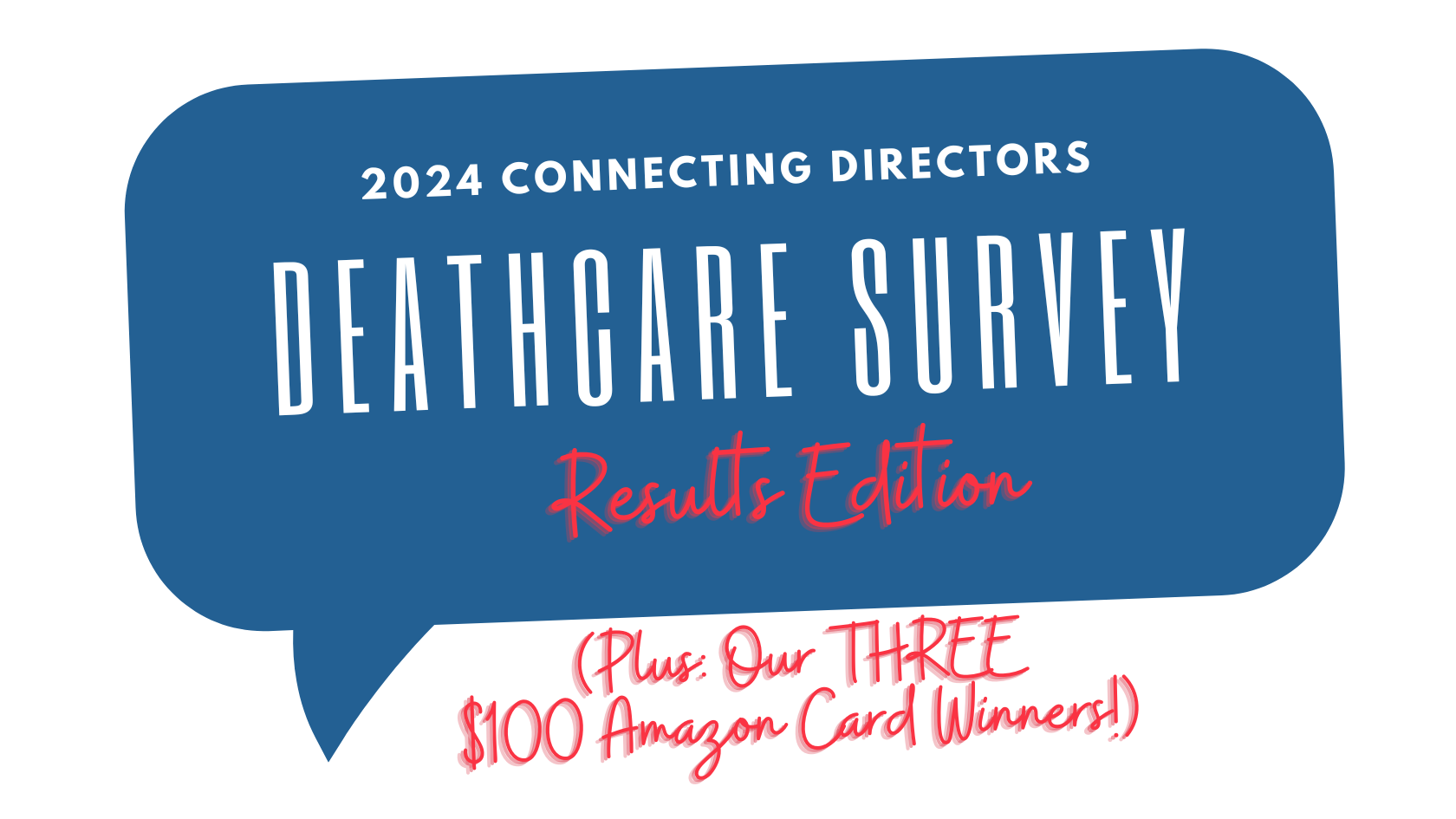Connecting Directors 2024 Deathcare Survey: The Results are In!
We’d like to offer our sincere thanks to the hundreds of Connecting Directors readers from 45 states who participated in our fourth annual Deathcare Survey! Your responses will inform and inspire the direction of our content going forward — and hopefully shed some light on how your experiences compare to those of your peers.
Before we share some of the insights gleaned from three years of surveys, though, we’re happy to announce the three randomly-selected winners of $100 Amazon gift cards:
- Connor Hellwig,
- Cliff Lynch, and
- Erin Phelps!
Congratulations Connor, Cliff, and Erin! Watch for your digital gift cards via email. Now, let’s dig into the data.
About our readers
For the last four years, the majority (41%) of our survey respondents have served primarily as funeral directors, owners, or managers in the Generation X age group. Survey-takers in the Millennial and Boomer generations both numbered 24%, with less than 1% self-reporting as Gen Z. Male respondents (73%) outnumbering females (28%) … We’d love to hear more from you, ladies!
The average number of calls managed annually dropped to 377, from 394 in 2023, and a most-likely COVID-related high of 475 in 2021.
Your cremation rates, expectedly, increased incrementally, from 51% in 2021, to 52% in 2022, to 53% in 2023, to 54% this year. This is only slightly lower than the latest (2022) cremation rate of 59% published by the Cremation Association of North America (CANA).
Shifting challenges
One of our goals with Connecting Directors is to provide relevant and helpful information that helps you address issues and overcome challenges. Your responses to several of our survey questions help us do that. For the fourth year in a row, your top challenge remains hiring and retaining great employees. Last year, exactly half of our respondents were struggling with hiring and retention, up from about one-third (33%) in 2021 and 45% in 2022. This year, only 44% reported that recruiting and retaining employees was their top challenge, indicating that the proverbial light at the end of the tunnel we described last (increasing mortuary school enrollment) might be approaching reality.
Another glimmer of hope … While dealing with compassion fatigue and mental health in general is still a major challenge, this year only 28% of respondents noted this as a top issue, tied with rising cremation rates. This is the lowest compassion fatigue number in the four-year history of the survey; it’s down from 35% in 2023 and a survey-high of 38% in 2022.
Replacing compassion fatigue in the second-place spot this year is the problem of dealing with difficult and/or dysfunctional families. In fact, 31% of respondents cited this as a challenge, up a few points from last year.
The most interesting information from this question this year was the appearance of a new challenge in the top 10: revenue generation skyrocketed to fourth place (27%) from 11th (18%) in 2023.
You (still) love your job!
Since 2021 we’ve asked the question, “Which SINGLE activity do you wish you could spend LESS TIME DOING?” We asked this in the hopes that we could find products, vendors, experts, etc. — anyone or anything that could provide assistance with or perhaps completely eliminate these unwanted tasks. In 2021, so many people added “Nothing! I love my job!” in the “Other” field that we added that response as an option. Now, how many professions can make a claim like that?
Last year, that response topped the list. This year, though, as in 2022 and 2021, you most wished to rid yourselves of the time-consuming duty of dealing with problem employees and coworkers.
Dealing with partners, including doctors, government officials, cemeteries, etc. rose up to fourth place (12%) in the list from sixth (9%) last year.
Getting the word out
When it comes to marketing techniques, “word of mouth/referral” still reigns supreme as the most popular (95%) and most effective (56%) methods you use to reach new families. Community involvement, a highly recommended tool for interacting with folks, is a close second in both categories (93% of you have tried it, and 30% find it effective).
Interestingly, though, although most of you have tried other methods of marketing — 73% have even used paid social media and search engine strategies — the tried-and-true tools still reign supreme. In fact, only 2% to 4% of respondents said that these alternative marketing methods have actually been the most effective techniques for their businesses.
The vast majority of respondents (48%) also shared that marketing is part of their job … on top of everything else you do as a deathcare professional. Another 23% are lucky enough to have a person on staff who takes care of that for you. And again, we have to throw in a gratuitous recommendation for the one-and-only Ryan Thogmartin and the DISRUPT team, who are always ready and willing to take this task off your hands!
Speaking of Ryan and friends and their areas of expertise, when it comes to social media, most of our respondents (82%) use Facebook to market their services as a deathcare professional, with Instagram (22%) and LinkedIn (16%) placing second and third.
Less “conventional” social media platforms for deathcare — YouTube, Twitter/X, Snapchat, and TikTok — remained at the bottom of the list for the fourth year in a row. Interestingly, the fourth place response in answer to the question of which social media channels you actively use was “None of the above,” with 15% of respondents reporting that they still don’t participate. Fifteen percent!!
Of course, in this digital age, where the average percentage of Americans who do not use social media was less than 7%, we wanted to know why. Apparently, most of the blame lies with the lack of time to implement, create, and monitor social media content; 34% of respondents said they’d use social media for their businesses if there were only more hours in the day, with another 15% saying they’d do it if they had someone else to manage it for them. Another 23% still aren’t convinced it’s actually worth the time and effort.
What’s next
These statistics are just the tip of the iceberg of the incredibly interesting data you shared with us in the 2024 Connecting Directors Deathcare Survey, and we’re excited to share it with you. Next up, watch for content that incorporates your responses (you’ll especially want to see what we found out about posting prices online!) and responds to your requests and needs. Stay tuned!




